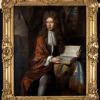Hooke's Micrographia, 1665
External links
Commentary
Image. Title page of Robert Hooke, Micrographia: or, Some physiological descriptions of minute bodies made by magnifying glasses. London: J. Martyn and J. Allestry, 1665. Source: National Library of Wales via Wikimedia (public domain).
Commentary. The famous diarist Samuel Pepys called it "the most ingenious book that I ever read in my life." The Micrographia was a book intended to showcase the unheard-of powers of the microscope, and to enhance the prestige of the newly established Royal Society. It featured high-impact engravings of objects that had never been seen before in so much detail (such as a fly's eye or a flea) or with the naked eye (e.g. the cellular structure of a cork).
This book, the Micrographia, was the first important work on microscopy, the study of minute objects through a microscope. First published in 1665, it contains large-scale, finely detailed illustrations of some of the specimens Hooke viewed under the microscopes he designed. At the end of the book, there are observations of the stars and moon as seen through a telescope. By changing our perspective, Hooke gives power and beauty to things that might otherwise be dismissed as disgusting or trivial – the surface of frozen urine, the eye of a grey drone-fly, a piece of moss, the body of a louse, an ant or a flea. Alongside the engravings, he writes entertaining accounts of his observations. Hooke is witty and even poetic, using similes to help us imagine the world he sees through his lenses.
Commentary derived from 'Micrographia by Robert Hooke, 1665', British Library Online, accessed 9/11/2018.
Resources
High resolution images of many of the engravings in this book are available from the National Library of Wales.
A high-resolution facsimile of the entire book is available at archive.org.
Will Poole gives a lively introduction to the Bodleian's copy of this book in the video embedded below.

